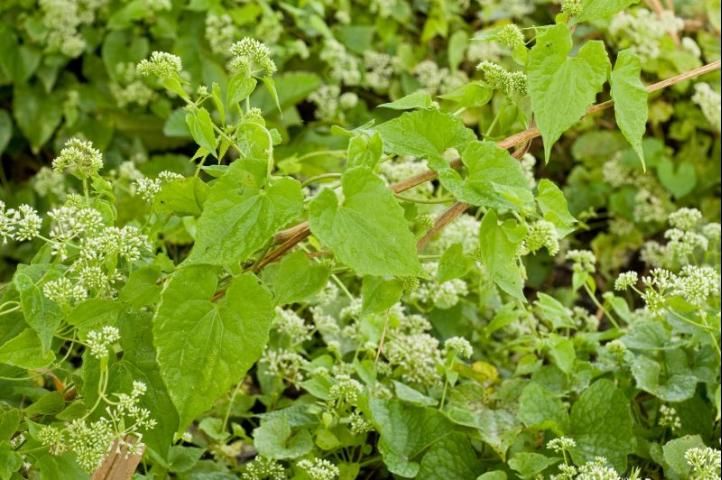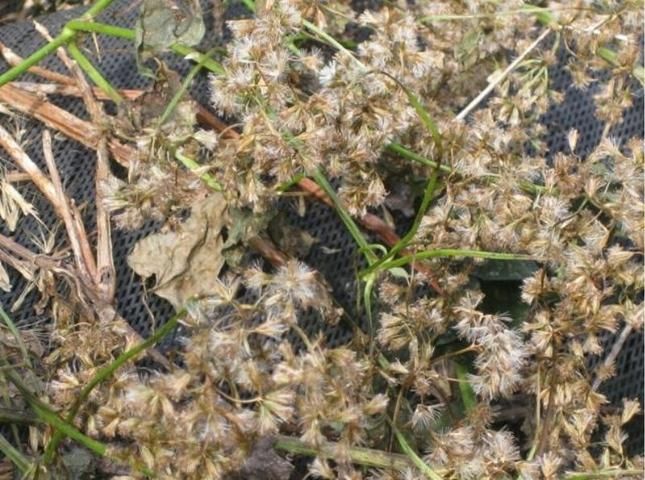A new weed was reported in late 2009 near Homestead, FL (Figure 1). After several consultations and DNA analysis, it was determined that the plant is Mikania micrantha, also known by common names mile-a-minute (WWSA Composite List of Weeds, January 2010), Chinese creeper, climping hempweed, and bittervine.
General Description
Mile-a-minute is a highly branched perennial vine. Leaves are opposite and heart-shaped (Figure 2), 2–5 inches long and 1–3 inches wide, and taper to an acute point. In Florida, it likely flowers in November and December, with seed set occurring primarily in December. Seeds are tufted (Figure 3), making them well-equipped for wind dispersal.

Credit: Keith Bradley
How Do I Identify Mile-A-Minute?
Identification of mile-a-minute is complicated because two very similar species are present in Florida. Climbing hempweed (Mikania scandens) looks very similar to Chinese creeper, but there are some differences. Mile-a-minute tends to grow in disturbed habitats, whereas climbing hempweed favors natural habitats. Mile-a-minute has very rapid growth compared to climbing hempweed, and has pale green or yellow-green leaves with green petioles and white flowers, whereas climbing hempweed has medium-green leaves with reddish petioles and pinkish flowers. The other similar species, Florida Keys hempvine (Mikania cordifolia), has hairy leaves and stems and larger flower heads compared to mile-a-minute and climbing hempweed.

Credit: Keith Bradley

Credit: Andrew Derkson
What Is Its Habitat?
Wet areas, forest borders, clearings, canal banks, rivers, roadsides, pastures, and other agricultural areas. Mile-a-minute generally invades disturbed areas. This plant does not typically grow well in heavily shaded areas.
Is It a Problem?
Simply speaking, yes. Mile-a-minute is a major environmental and agricultural threat. Currently, it is recognized globally as a top 100 invasive species. It is a significant pest in plantation crops and commercial forests in West Africa and India and throughout Southeast Asia and the Pacific Islands. It produces tens of thousands of fine, wind-blown seeds that disperse easily over vast areas. It also reproduces asexually and can regenerate from small cuttings.
Growth of mile-a-minute is quite rapid. It can grow at rates of at least three feet per week. This high rate of growth allows mile-a-minute to smother existing vegetation quite quickly, reducing desirable species' access to light.
How Is It Controlled?
Mechanical control through cutting is not beneficial because this weed regrows quickly from cuttings. Uprooting and digging, though very labor-intensive, are the primary mechanical method for control. We are suggesting that all plant material be incinerated if plants are removed by hand.
Chemical control methods in Florida include timely applications of glyphosate, triclopyr, fluroxypyr, or aminopyralid. These must be applied prior to flowering. A 3% by volume solution of glyphosate (Roundup, etc.) in water or triclopyr (Garlon, etc.) at 1–2 pints per acre will likely be sufficient for control. Excellent control of mile-a-minute in Australia has also been found with fluroxypyr (Vista) at 1 pint per acre, and we have confirmed that this herbicide is extremely active under greenhouse conditions. Aminopyralid (Milestone) provided good control at 5 to 7 oz/A. Herbicides should be chosen based on the location where mile-a-minute is being treated and should be labeled for that particular site. Frequent scouting of the infested and surrounding areas should be performed to treat any escapes or regrowth.
What Do I Do if I Find This Weed?
Because this weed shows growth reminiscent of Old World climbing fern, which has invaded many natural areas in South Florida, it is imperative that control efforts on individual populations begin immediately. To date, at least 130 separate locations in the Homestead area have been identified, and with the wind-blown seeds, there are likely to be more. If this weed is found in South Florida, please contact Florida Division of Plant Industry at 888-397-1517.